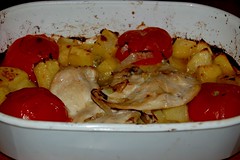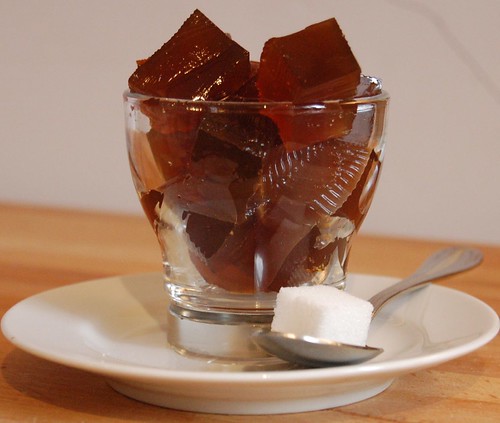Bet you thought I’d forgotten about my cookbook challenge, didn’t you? Things have been going on in the background though — not all of them entirely successful.
Due to “technical difficulties” there is no photo of this particular recipe from Delicious Days, but it was really lovely. In a glass, a layer of panna cotta is allowed to set for a few hours, and is then topped with a thin layer of coffee jelly. I let the coffee cool for 10 minutes as instructed, and spooned it carefully onto the panna cottas. They looked lovely, a symphony in black and white. But when I took them out of the fridge a couple of hours later, the still-liquid coffee had managed to insinuate itself down the sides of the glasses in dark streaks, so it really didn’t look very attractive! It tasted gorgeous though, the strong coffee complementing the mild creaminess of the panna cotta perfectly. Next time — and there definitely will be a next time — I will let the coffee almost set before adding it.
I twiddled the recipe a bit; the coffee was actually supposed to be Kahlua, but I’m not a liqueur drinker, and I wasn’t about to buy a whole bottle just for this. I first discovered Delicious Days via Nicky’s recipe for coffee jelly, so it seemed entirely reasonable to use this: I just made a cup of very strong espresso and sweetened it before adding the gelatine. Taking a leaf out of Pascale‘s book, I also substituted a couple of tablespoons of crème fraîche for part of the cream; I’ve done this before and it really enhances the flavour of the panna cotta, especially when you can only get nasty UHT cream. It still amazes me how something as simple as “boiled cream” can be so very good.
I’ll take this opportunity to mumble quietly about a couple of other less successful attempts from the book: the smoked trout, red onion, fennel and orange salad was a nice idea, and looked attractive, but there was far too much onion, and we felt the flavours didn’t really work together that well. No photo, we were entertaining and I didn’t have time to take one.
The caramelized almonds suffered from my following the instructions too closely; “after 5-8 minutes the liquid will have evaporated and the sugar covers the almonds with a dry crust”. This didn’t happen, and I was just musing that the cinnamon in the syrup made it hard to see just how caramelized it was when — sniff, sniff — aargh! I snatched the pan of the heat and quickly tipped the almonds onto the prepared baking tray. They were only just the right side of burnt. I didn’t photograph them because they would have looked like cockroaches, but if they had been just a fraction less done they would have been really nice. As it was, they were still OK as a nibble with drinks.


